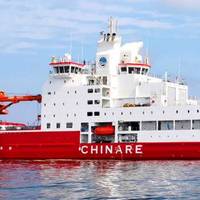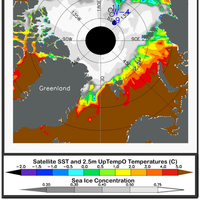China's Polar Icebreaker Embarks on First Arctic Mission

China's first domestically built polar icebreaker Xue Long 2 has set sail on its first mission to the Arctic, China's state-run Xinhua News Agency reports.Xuez Long 2 (Snow Dragon 2) departed Shanghai Wednesday with a team of Chinese scientists on board to conduct investigations in areas including the Chukchi Rise, Canada Basin and the central Arctic Ocean, Xinhua reports. The voyage is expected to cover some 12,000 nautical miles and conclude in late September.The expedition is said to be organized by China's Ministry of Natural Resources to study biodiversity and ecosystems…
Arctic Sea Ice Melt Continues

As of August 14, Arctic sea ice extent is tracking third lowest in the satellite record, according to the National Snow & Ice Data Center (NSIDC). The southern route through the Northwest Passage appears to be largely free of ice. Despite a rather diffuse ice cover in the Chukchi Sea, it is unlikely that Arctic sea ice extent this September will fall below the record minimum set in 2012. As of August 14, Arctic sea ice extent was 5.61 million square kilometers, the third lowest extent in the satellite record for this date and slightly below the two standard deviation range.
Ice algae: The Engine of Life in the Central Arctic Ocean
Algae that live in and under the sea ice play a much greater role for the Arctic food web than previously assumed. In a new study, biologists of the Alfred Wegener Institute, Helmholtz Centre for Polar and Marine Research (AWI) showed that not only animals that live directly under the ice thrive on carbon produced by so-called ice algae. Even species that mostly live at greater depth depend to a large extent on carbon from these algae. This also means that the decline of the Arctic sea ice may have far-reaching consequences for the entire food web of the Arctic Ocean. Their results have been published online now in the journal Limnology & Oceanography. The summer sea ice in the Arctic is diminishing at a rapid pace and with it the habitat of ice algae.
Sea Ice Plays Pivotal Role in Arctic Methane Cycle
The ice-covered Arctic Ocean is a more important factor concerning the concentration of the greenhouse gas methane in the atmosphere than previously assumed. Experts from the Alfred Wegener Institute, Helmholtz Centre for Polar and Marine Research (AWI) report on the newly discovered interactions between the atmosphere, sea ice and the ocean in a recent online study in the journal Nature’s Scientific Reports. Sea ice forms a natural barrier on the Central Arctic Ocean, limiting gas exchange between water and atmosphere. Over the past several years, the summer sea ice cover in the Arctic has rapidly decreased. “We’re investigating how the changed conditions are affecting the geochemical interaction between the ocean…
Russia, US Agree on Arctic Fishing Ban
Five nations set moratorium on fishing near North Pole; no fish there now, but thaw is drawing stocks north. The United States, Russia and other Arctic nations signed an agreement deal on Thursday to bar their fishing fleets from fast-thawing seas around the North Pole, an agreement delayed more than a year by tensions over Ukraine. The accord, also signed in Oslo by the ambassadors of Canada, Norway and Denmark, is a response to global warming, which is melting sea ice in the central Arctic Ocean, an area the size of the Mediterranean. The central Arctic probably has no commercial fish stocks now, experts say, but melting sea ice may draw fish such as cod farther north. Forty percent of the area was briefly open water when summer sea ice shrank to a record low in 2012.
Arctic Sea Ice Decline
Sea ice in the Arctic Ocean is at its lowest May level since records began in the 1980s, says Al Jazeera. The lowest levels in the history of Arctic sea ice observation for this time of year and likely the lowest levels for hundreds, even thousands of years. The problem is not just one of a new record low. It’s one of timing and divergence. Accelerated melt in the May-to-June time-frame can have serious impacts on late season ice. The reason is that greatly reduced ice coverage also reduces albedo or reflectivity. The result can be compounded warming and increased heat absorption by darker surfaces under the 24 hour Arctic sunlight of June and July. When compared with a 30 year average of 12.5m sq km, the current ice coverage around the North Pole is just 11.32m sq km.
RV Polarstern Sets Course for Spitsbergen
On Tuesday, 19 May 2015 the research icebreaker Polarstern will leave its home port in Bremerhaven, setting a course for the Arctic. Led by Dr Ilka Peeken from the Alfred Wegener Institute, Helmholtz Centre for Polar and Marine Research (AWI) a team of 53 researchers from 11 countries will investigate the effects of climate change in the Arctic, from the surface ice floes down to the seafloor. RV Polarstern will enter the sea-ice zone north of Spitsbergen. Covering two shallow regions on their way to deeper waters, the scientists on board will focus on the processes at work in the ice-covered central Arctic Ocean. Their findings will then be used to supplement the research efforts of late-summer expeditions from the past several years.
Russia's Floating Research Station Unfolds in the Arctic
The Russian Ministry of Natural Resources says that Russia plans to establish a floating research station in Arctic sea. The floating research station “North Pole-41” is already in the making, says the Ministry statement. The Ministry says that the station will be an important instrument in securing Russian presence in the Arctic and will give Russia the opportunity to set new priorities for the scientific research on the drifting ice. "At present the deployment of seasonal scientific drifting station" North Pole-2015 is the only possible scientific research way in the North Pole"- the ministry said. In 2013, the Ministry of Natural Resources decided to evacuate the High North station “North Pole-40” when the ice floe began to break down.
Arctic on Thin Ice
Arctic sea ice - the ice that freezes and floats on Arctic waters - is thinning at a steadier and faster rate than researchers previously thought, a new study finds. Using modern and historic measurements, the researchers got an extensive view of how the thickness of Arctic sea ice has changed over the past few decades. According to measurements from multiple sources, the ice in the central Arctic Ocean thinned 65 percent between 1975 and 2012, from 11.7 feet (3.59 meters) to 4.1 feet (1.25 m). The results of studies conducted by University of Washington researchers show a thinning in the central Arctic Ocean of 65 percent between 1975 and 2012. September ice thickness, when the ice cover is at a minimum, is 85 percent thinner for the same 37-year stretch.
Russian Application to Extend its National Arctic Boundaries
In 2014, Russia plans to submit an application for extension of the boundaries of the continental Arctic Shelf to the special UN Commission after modifying and reinforcing the application by the results of additional research, reports 'Arctic info'. Citing remarks by Denis Khramov, Deputy Minister of the Ministry of Natural Resources and Ecology of Russia, 'Arctic info' says that Russia had already applied for extension of the territories in the Barents, Bering and Okhotsk seas, as well as in the Central Arctic Ocean. The Commission generally recognized the application as meeting the requirements but requested the Russian Federation to provide an additional proof that the ranges of Lomonosov and Mendeleev…
Kongsberg Maritime Multibeam Echo Sounder Chosen for Icebreaker
Kongsberg Maritime has been awarded a $3.2m contract to provide an EM 122 1ºx 1º multibeam hydrographic echo sounder and one 3º SBP 120 sub bottom profiler to the University of Stockholm and the University of Gothenburg, Sweden. The Knut and Alice Wallenberg foundation have financed the purchase together with the Swedish Research Council. The system is to be installed on the Icebreaker Oden, which is owned and managed by the Swedish Maritime Administration, Norrköping, Sweden. Oden built by Götaverken-Arendal in Gothenburg in 1987 is a 107m icebreaker vessel with 19 crewmembers and a top-speed of 15 knots. The EM 122 12 kHz multibeam echo sounder is designed to perform seabed mapping - bathymetry and seabed imagery - to full ocean depth with an unsurpassed resolution…







